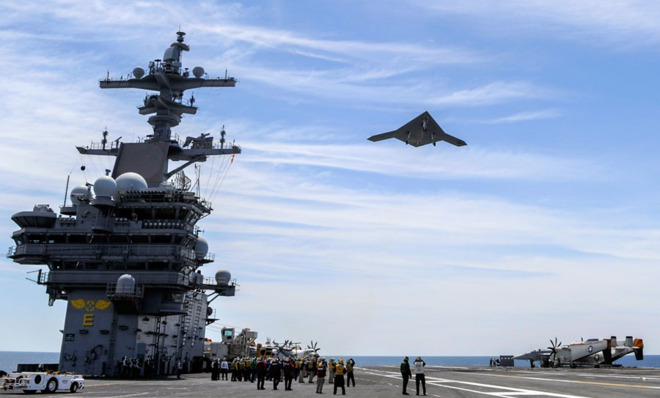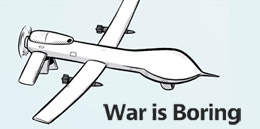Watch out, China — America is working on dogfighting drones
Science agency, Navy want robots to kill warplanes


The U.S. military appears to be assembling all the technology for robotic jet fighters to be able to shoot down enemy planes.
This is a big, big deal. Able to fly farther and stay in battle longer than manned planes, drones could help solve the most pressing problems facing American air power in the vast Pacific. Namely, distance and sortie rate.
The Pentagon's fringe-science Defense Advanced Research Projects Agency reportedly met on Feb. 28 to explain to defense industry officials what the agency wants from the new Distributed Battle Management program.
The Week
Escape your echo chamber. Get the facts behind the news, plus analysis from multiple perspectives.

Sign up for The Week's Free Newsletters
From our morning news briefing to a weekly Good News Newsletter, get the best of The Week delivered directly to your inbox.
From our morning news briefing to a weekly Good News Newsletter, get the best of The Week delivered directly to your inbox.
DBM is software meant to automate decision-making in aerial battles "involving manned combat aircraft as well as fighting drones," according to Military and Aerospace Electronics magazine.
"The program will address how to manage the increasing complexity of manned and unmanned aircraft," the magazine continued.
In other words, old-school jets and new-style drones are getting so sophisticated — and future air battles are expected to be so intense — that computers need to make more of the decisions about who shoots at what.
Not coincidentally, drones rely heavily on computerized autopilots, even if they do have human controllers guiding them via satellite from some remote ground station.
A free daily email with the biggest news stories of the day – and the best features from TheWeek.com
The DBM software could help meet the needs of the Navy's planned new drone warplane. Last summer the sailing branch began landing and launching a pair of Northrop Grumman X-47B test drones aboard aircraft carriers off the East Coast.
The X-47B is supposed to lead to a combat-capable drone known as the Unmanned Carrier-Launched Aerial Surveillance and Strike system, or UCLASS. The Navy wants stealthy, armed, jet-powered UCLASS drones on its 11 flattops by the 2020s.
Originally conceived of as a modest robotic recon plane able to carry some small weapons like the Air Force's propeller-driven Predator and Reaper drones, UCLASS could evolve into a powerful and heavily-armed fighter as big as a 40-ton F-14 Tomcat — the Navy's classic Cold War jet.
Rep. Randy Forbes, the Virginia Republican who chairs the House of Representatives' Seapower and Projection Forces subcommittee, has been pressing the Navy to pack as much fighting ability as possible into the UCLASS drone, giving it "enduring utility in tomorrow's threat environment," Forbes wrote to Secretary of the Navy Ray Mabus.
The Navy brass is open to the prospect of a tougher drone — one able to fight other planes in addition to spying and firing missiles at people on the ground.
Rear Adm. Mike Manazir, the Navy's director of air warfare, told U.S. Naval Institute reporter Dave Majumdar that UCLASS could follow manned fighters like the F/A-18 and F-35 into combat. The manned planes would spot targets and the UCLASS would fire air-to-air missiles, functioning as a sort of "flying missile magazine," Manazir said.
DARPA's new software might go a step farther and, by partially automating engagements, give the drone greater ability to fight on its own — no wingman required. The BDM code "will enable execution of complex kill chains in real time," the agency stated.
It's clear the Pentagon needs a dogfighting drone, especially as it shifts forces to the Pacific to counter a rising China. The U.S. military's main air bases in Japan and Guam are many hundreds of miles from potential war zones such as the Taiwan Strait, whereas China's air bases are a few score miles away.
American aircraft carriers theoretically can sail close to the battle zone, but in practice the threat of Chinese ballistic missiles could keep the flattops a thousand miles from the main fighting.
Forced to fly hundreds of miles in order to reach battle, U.S. jets could run out of fuel a few minutes after arriving. And the great distances also limit the pace at which commanders can send more planes into the fight, since too many aircraft will be tied up in transit.
"Without secure close bases, sortie rates rapidly decline," the California think tank RAND warned in a 2008 study.
Dogfighting drones could change all that. Loaded with missiles, a robotic warplane could linger for 12 hours or more over the battlefield, extending American firepower against waves of Chinese planes.
From drones to AKs, high technology to low politics, War is Boring explores how and why we fight above, on, and below an angry world. Sign up for its daily email update here or subscribe to its RSS Feed here.
More from War is Boring...
-
 A lemon-shaped exoplanet is squeezing what we know about planet formation
A lemon-shaped exoplanet is squeezing what we know about planet formationUnder the radar It may be made from a former star
-
 Political cartoons for January 4
Political cartoons for January 4Cartoons Sunday's political cartoons include a resolution to learn a new language, and new names in Hades and on battleships
-
 The ultimate films of 2025 by genre
The ultimate films of 2025 by genreThe Week Recommends From comedies to thrillers, documentaries to animations, 2025 featured some unforgettable film moments